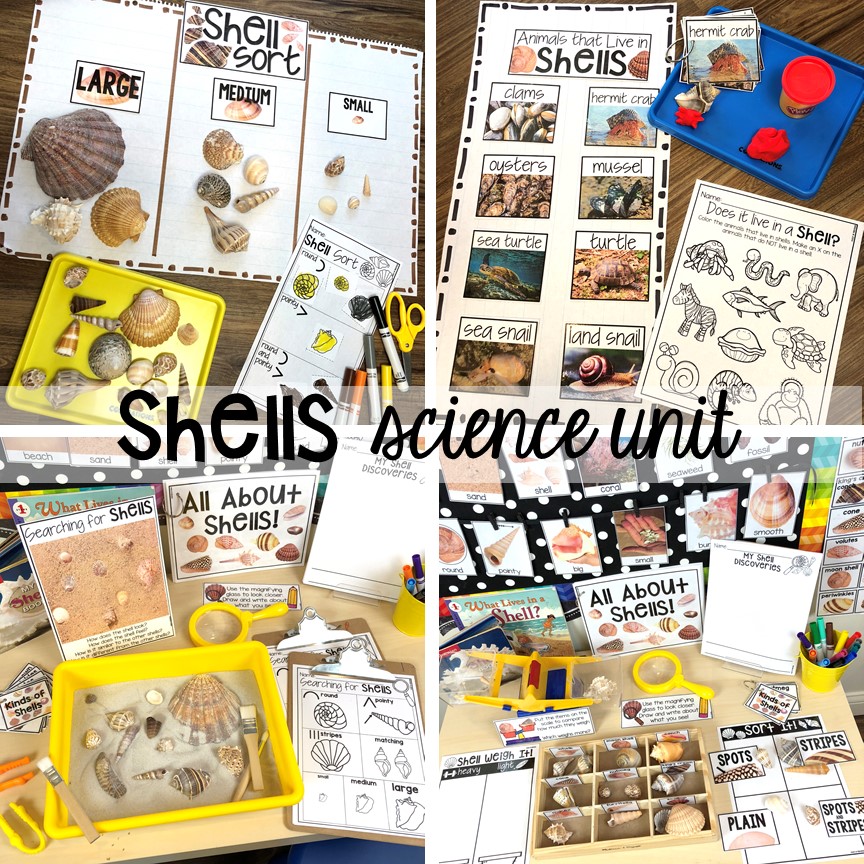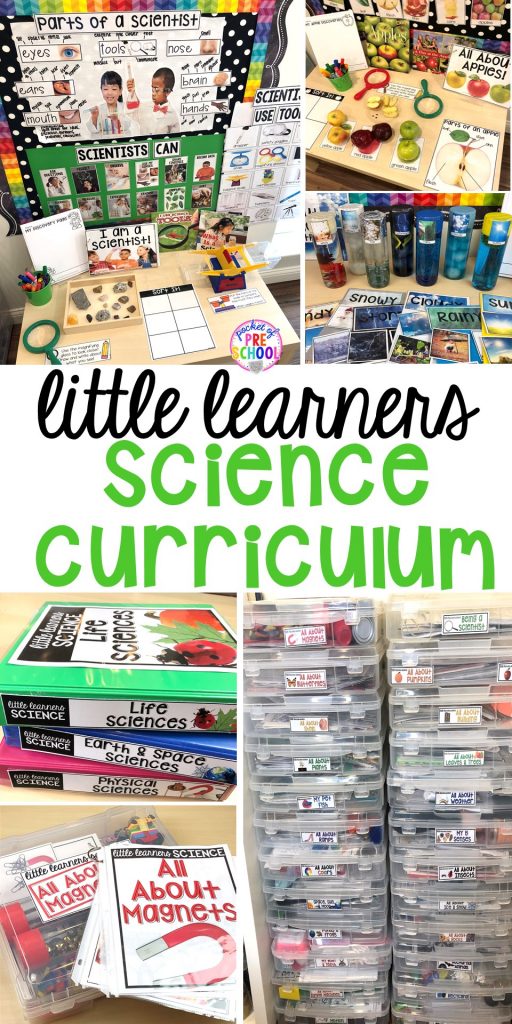Little Learners are captivated by science! In this post, we’re talking all about the Little Learner Science Curriculum, and hopefully answer the questions you may have about it. First things first, the curriculum has been designed specifically for preschool, pre-k, and kindergarten using the NGSS standards, various state standards as well as current research. Research tells us students learn by doing, feeling, touching and examining so that ‘s just what this science curriculum is packed full of! I have included hands-on science activities that are appropriate for little learners.
This post contains affiliate links.
<< You can grab the Little Learner Science Curriculum Bundle HERE or the individual Little Learner Science Units HERE from mt TpT store. >>
I would like to stress my approach when compiling this curriculum: this science curriculum is NOT about teaching random science facts. It IS about teaching students science skills and methods as well as an awareness of the world around them and all the things in it. For example, I do not expect my little learners to recall the stages of the lifecycle of a plant. However, I do want them to demonstrate an awareness that all living things go through a life cycle. Taking a piece of knowledge and applying it to new scenarios is a wonderful skill to learn!
This science curriculum focuses on developing scientific inquiry skills such as observing, investigating and experimenting rather than the “right answer” or doing something “right way”. The process is more important than the product!
How and When You Can Use it in Your Classroom
Set up a science center (read all about my science center HERE) with a science table. The science table is where we do focused investigations on a topic or theme.
Science Table or Shelf: Use a small table or a small bookshelf to create an engaging science table full of hands-on materials for students to explore and investigate! The table I have is this coffee table from Ikea. This is where most of the learning occurs: at the science table during center time. This curriculum will give you all the tools you need to make the science table an inviting place with rich vocabulary and meaningful hands-on experiments and investigations. Almost everything in the science curriculum has REAL photographs! Read all about how I manage center time HERE.
Every year I always start the year with the Being a Scientist unit because you will have to teach your little scientists the tools scientists use and how to use them. The Five Senses unit is another unit I do the first few months to build their background knowledge of how to be a scientist and build those science skills. Check out my FREE Curriculum Map HERE, and see how I plan out the year infusing science based on the learning themes.
If students are still wanting to investigate a topic or love a certain activity, I move it to my science shelf so they can still access it. Then I put out a new topic at the table.
Science Read Aloud & Connecting Activity: Read a science book during circle time, then do one of the connecting activities found in each unit, or model a science skill. Each unit has a suggested reading list with amazing books or use the included read aloud. The connecting activities can be anchor charts, interactive charts, experiments or hunts (ex: nature hunt or a listening hunt).
Science Talks: During circle time, engage students in a “science talk”! These are simple, but powerful ways to engage your students in science. Students learn so much from listening and observing their peers. If you are not doing science talks, I recommend you start immediately! Once science talks become common and students understand the flow of them, they will start having science talks with their peers at the science table with no prompting! A science talk can be a time when I…
- introduce the new science study/topic.
- discuss vocabulary words (showing the vocabulary cards).
- share students’ ideas, misconceptions and findings.
- test students’ discoveries.
- complete included charts.
- pose and investigate one of the included questions or challenges.
How long can you use a unit?
It totally depends on your classroom, student interest, amount of activities in the unit and what you want to do. These units can be used for a month or two weeks. Maybe you just want to use a few parts of a unit for a week to go with a theme or holiday. The beauty of running your own classroom is that it’s totally up to you.
I would suggest using it for at least two weeks so students can dive deeper into a concept rather than just skimming the surface. It also depends on how much time during your school day you can devote to science. Decide on a general amount of time each week that will be devoted to science such as one circle, one table time or arrival and one small group. Plus the science table will be used by students independently each day.
Let’s take a closer look at one of the units! Here is the All About Weather Science Unit!
Weather is a tricky one because the weather is outside, and we are inside our classroom. You can still set up hands-on experiments and investigations for even the tricky science concepts. For example, set up the Wind Will It Blow experiment (pictured in the bottom right corner). Create sensory bottles that represent various types of weather, then examine and sort real photographs of weather. Why not create various types of clouds with cotton balls using real photographs for support? The goal is not to memorize the different kinds of clouds but for students to notice and compare the different types of clouds and make representations of their conclusions and ideas.
We want students to be real scientists at the science table! They achieve this by doing the following
- using science tools
- sorting and classifying
- measuring using non-standard and standard measurement tools
- observing and examining
- engineering and constructing
- collecting and interpreting data
- recording their findings (every unit has a discovery page so students can draw or write)
- talking and collaborating with peers and teachers
- predicting
- wondering and questioning
- then investigating those questions!
- problem-solving

Here is a list of basic science tools I use and love:
- magnifying glasses
- balance scale
- magnets or magnet set
- connecting cubes
- platform scale
- tweezers
- droppers
- bear counters
- sensory bottles (12 oz)
- sensory bottles (550 ml) – these are the bigger ones I was using then they increased the price
- small animals like these (mine are mostly Toob from Michaels, and I always use a coupon or wait until they go on sale to buy them)
- themed items based on the unit (ex: rocks for the rock unit, apples for the apple unit)
- fake leaves and fake flowers (Dollar Tree)
- other things from nature (shells, rocks) from the Dollar Tree
- science books! CLICK HERE to go to my Amazon storefront to see the books I suggest if you need or want more quality, appropriate non-fiction books (once you go to the page, click the science button). Only some of the book suggestions are on the list so I’ll work on getting those added. There is a book list in each unit.

- book rings
- Velcro dots
- Astrobrights paper (this one, this one, and this one are my favorites)
- chart paper (big or small)
- chart paper markers
- small trays – cheaper if you buy them from Discount School Supply and sometimes the Dollar Tree has them
- large trays (size that fits a piece of paper easily) from Lakeshore or Target spot during back to school
- clear sorting tray (4 spots: Walmart or 3 spots: Dollar Tree)
- wooden tray
- mini easel to hold books and one-page posters (Target spot during back to school), picture frame holders will also work
- Iris plastic tubs – can also find at Michaels (wait until they are on sale to buy them)
- Sheet Protectors
- laminator
- lamination pouches
Each science unit has labels included and now has corresponding binder covers and spines! I use these Iris Scrapbook Tubs from Michales or Amazon to store each unit. You can get them from your local Michales stores and use your teacher discount or wait for a sale. I’m not a binder girl so I place the unit in page protectors and bind with a book ring. Then I place the unit in the tub with all the printables from the unit and anything I made for the unit (like these magnetic sensory bottles), or other items specific to that unit.
Or
For my “binder teachers” out there, you can make a binder for each unit, one giant binder (or two), or create a binder for each science area (life sciences, earth and space sciences and physical sciences) like in the photograph below. Then each unit cover as a divider.
>> Grab the FREE Science Binder Covers and Spines HERE <<
This is my giant stack of science unit tubs! Now that they are all prepped, this year I can just grab the unit tub I need and pull out the activities and items I want to use.
What can be included in each science unit:
• Teacher Instruction Strategies
• Science Center Set-Up (with real classroom photos of the center in action)
• Vocabulary Cards
• Discovery and Science Journal Pages and Covers (many options included)
• Anchor Charts, Interactive Charts or Posters
• Experiments
• Sorting Boards and/or Charts
• Hands on Activities
• Read Aloud Non-Fiction book
• Half-page parent/family note
I’m sure are you as pumped and excited about teaching science and setting up amazing science resources for the little scientists in your classroom. I know I am! Tons and tons of teachers have reached out to me this year telling me how they love teaching science now (when they dreaded it before), or that the science center is the most popular center in their classroom. That’s truly the best compliment ever! I love to hear that students choose to play in the science center! It makes my teacher heart so happy to hear about how students are falling in love with science! We need more smart, capable scientists in our world discovering ways to solve our problems and saving our planet!
Did you know that the St. Louis Science Center is using THIS curriculum in the science center? My mind was blown away when they contacted me, and they didn’t even know that I lived in St. Louis. You can tell families that the science curriculum you are using is not only research and standards based, but it’s the same curriculum an actual science center is using.
Get the Little Learners Science Curriculum Bundle and SAVE BIG! Get ALL 25 little learner science units in this Science for Little Learners BUNDLE!
If you want to see individual science units, watch a Facebook live! I did a Facebook live on each science unit so you can see it in action and see everything that is included. CLICK HERE for my Facebook Live clickable video list.
Here is a peek at some of the units in action!
What are you waiting for? Grab the Science for Little Learners BUNDLE and ENJOY teaching science again!
Love it? Pin this image!































